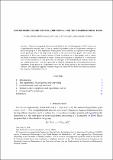Logarithmic Picard groups, chip firing, and the combinatorial rank
Author(s)
Foster, Tyler; Ranganathan, Dhruv; Talpo, Mattia; Ulirsch, Martin
Download209_2018_2085_ReferencePDF.pdf (201.8Kb)
Publisher Policy
Publisher Policy
Article is made available in accordance with the publisher's policy and may be subject to US copyright law. Please refer to the publisher's site for terms of use.
Terms of use
Metadata
Show full item recordAbstract
Illusie has suggested that one should think of the classifying group of M[superscript gp] [subscript X]-torsors on a logarithmically smooth curve X over a standard logarithmic point as a logarithmic analogue of the Picard group of X. This logarithmic Picard group arises naturally as a quotient of the algebraic Picard group by lifts of the chip firing relations of the associated dual graph. We connect this perspective to Baker and Norine’s theory of ranks of divisors on a finite graph, and to Amini and Baker’s metrized complexes of curves. Moreover, we propose a definition of a combinatorial rank for line bundles on X and prove that an analogue of the Riemann–Roch formula holds for our combinatorial rank. Our proof proceeds by carefully describing the relationship between the logarithmic Picard group on a logarithmic curve and the Picard group of the associated metrized complex. This approach suggests a natural categorical framework for metrized complexes, namely the category of logarithmic curves.
Date issued
2018-06Department
Massachusetts Institute of Technology. Department of MathematicsJournal
Mathematische Zeitschrift
Publisher
Springer Berlin Heidelberg
Citation
Foster, Tyler et al. "Logarithmic Picard groups, chip firing, and the combinatorial rank." Mathematische Zeitschrift 291 (June 2018): 313–327 © 2018 Springer-Verlag GmbH Germany, part of Springer Nature
Version: Author's final manuscript